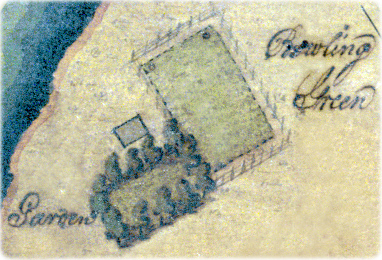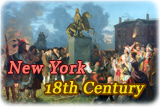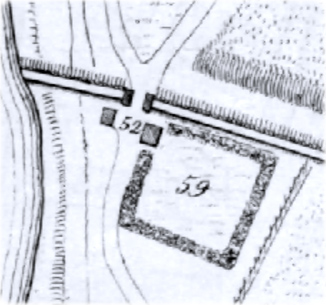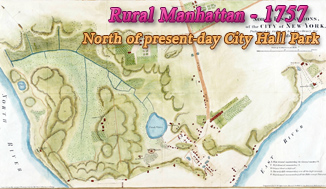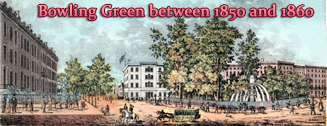The old Bowling Green Garden operated in the early 18th
century in a tract of land, part of the
old Church Farm. It was a place of resort, refreshment and entertainment and it
was composed of a tavern,
a bowling green and a garden (see drawing on the right). It was located near the
North (Hudson) River, between what is now Warren and Chambers streets, in
Tribeca neighborhood of Lower Manhattan.
In 1733, an area in the present-day Bowling Green, New York City's oldest park, near the Battery, was leased for a bowling green.
The old Bowling Green Garden operated for some time before 1728 (when it was represented in the James Lyne map) until about the 1730s.
This was not the first bowling green in Manhattan. According to Stokes (Iconography of Manhattan Island, 1922), by 1701, there was another bowling green on the shore of the East River. The area was granted by the City to Richard Sackett (1678-1746), on June 4, that year. It extended from the present (1922) James Slip to Peck Slip and from Cherry to Water streets. Sackett kept, on the place, his brew-house, a pleasure garden, tavern, and bowling-green, commonly known as the Cherry Garden or Sackett’s Orchard.
The tract of land of the old Bowling Green Garden, on the North River waterfront, was originally owned by the Dutch West India Company, during the Dutch rule of New Amsterdam (now New York), in the 17th century. In 1664, the English took over the City and it became the Duke's Farm. Then, in 1674, it became the King's Farm, and the Queen's Farm in 1702. In 1705, Queen Anne granted this land to Trinity Church, then it became known as Church Farm.
In 1735 the house of the old Bowling Green Garden was leased and occupied by John Miller, who offered garden seeds of several sorts for sale. On March 29 1738, the "House at the old Bowling Green took Fire and in a few Minutes was reduced to Ashes. The Wind at that Time was high and the House far from any Assistance, Mr. Miller who then lived in it with great Difficiulty saved him self and his Wife, being rather to eager to save some Goods which they could not effect. To avoid the Flames they were obliged to leapt out of the Windows one Story high." (from the New York Journal, Apr. 3). An investigation by a committee from Trinity Church considered that the fire was accidental. Miller was given permission to turn back his lease in July and a new house was built. By March 25, 1739, Miller vacate the church's farm.
In 1752, Adam van Denberg, who had a tavern and garden on the Church Farm, at the present Broadway and Vesey Street, leased the old Bowling Green from Trinity Church, for 21 years, from March 25.
Denberg passed the lease to John Marshal, on February 1st, 1759, and the place was called Mount Pleasant. On November 10 of that year, the militia company of grenadiers met on the place to celebrate the king's birthday, when they roasted an ox and ate and drank loyally. Marshall opened his house for breakfast every morning and solicited the patronage of ladies and gentlemen during the season of 1759.
In 1762, the house and gardens were again offered for sale. John Elkin succeeded Marshall and renamed the place Spring Gardens. In addition to breakfast, he offered an afternoon tea with pies and tarts, as well as mead and Madeira wine.
In 1764, Fraunces succeeded Elkin and the place was renamed Spring Gardens Vauxhall. At that time, the property contained twenty-seven and a half lots of ground.
